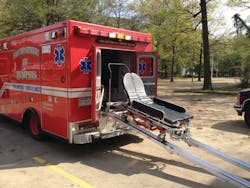EMS: Responding to Emergencies Involving Bariatric Patients
It must be a sign of the times. More and more fire departments are implementing bariatric ambulances to accommodate the ever-expanding waistlines of Americans.
According to the U.S. Centers for Disease Control and Prevention (CDC), Americans are one inch taller and a sizeable 25 pounds heavier than they were in the 1960s. But even though Americans are taller, that does not account for all the extra weight, since body mass index (BMI) also increased over the same period. Figures from the CDC show that 64% of the U.S. adult population is overweight and nearly a 15% is morbidly obese, or roughly 100 pounds overweight. But even though Americans weigh an average of 25 pounds more than they did some 40-plus years ago, what we are seeing is more and more Americans who weigh in excess of 500, 600, 700 and in some cases 1,000 pounds.
I could write down all the reasons why Americans are bigger, but that would not change the fact that firefighters are forced to deal with patients who are extremely obese and must respond to emergencies involving these patients routinely. In my March 2004 column, “Necessity Is the Mother of Invention,” I detailed how Captain Manny Chavez of the Houston, TX, Fire Department invented a transporting device for obese patients called the ManSAC. The ManSAC is an oval carrier that would bring the mass to the center while distributing the weight. The first device was fashioned with PVC vinyl and seatbelt webbing and there were 10 handles on it so the weight of the person could be distributed to a maximum of 10 different people. The device was capable of carrying 1,600 pounds. Since then, other companies have manufactured facsimiles of the ManSAC.
But even then, patients had to be transported while lying on the floor of the ambulance in a ManSAC or one of the facsimiles since they could not fit on stretchers and thus could not be loaded into an ambulance while lying on a stretcher. To facilitate transporting these patients to the hospital, it became necessary to remove the stretcher and place patients on the floor of the ambulance.
Since then, fire departments have begun treating and transporting these extremely obese patients with specially built bariatric ambulances. Bariatric ambulances typically are more expensive than normal ambulances and are equipped with specialized equipment so they can perform their duties properly. This usually means they have hydraulic patient lifts or access ramps, larger interiors, cot-loading systems and inbuilt power supplies and hydraulics or winches.
One fire department that recently started using a bariatric ambulance is the Memphis, TN, Fire Department, which handles more than 106,500 EMS runs a year and sees about one extremely large obese patient a week (see “Memphis Fire Department Standard Operating Procedures: Bariatric Unit” on page XX).
The new bariatric ambulance in Memphis will allow obese patients to be transported with dignity since they will not be lying on the floor and hopefully it will save the backs of firefighters who sometimes have injured themselves lifting extremely obese patients into the ambulance. Stretchers on bariatric ambulances are extra wide and typically, depending on the brand, can accommodate patients up to 1,600 pounds.
Retrofitted ambulance
Instead of buying a new ambulance, the Memphis Fire Department retrofitted a reserve ambulance at the cost of only about $5,000. This included modifying an existing stretcher with an extra-wide board, new stretcher wheels, ramps and a winch with a cable for pulling the stretcher into or out of the ambulance.
The Memphis bariatric ambulance is not staffed and is housed at an engine house with an engine company. The bariatric ambulance is only used for stable patients who weigh more than 500 pounds and where transport is difficult because of their physical condition or the abilities of the patients to move, the capabilities of the available personnel or the patients’ size prevents them from being safely secured to a regular stretcher.
Whenever a firefighter/paramedic on another ambulance calls for a bariatric ambulance using any or all of the criteria in the previous paragraph, the engine company that is housed with the bariatric ambulance brings it to the scene as a task force and assists with the patient all the way to delivery at the hospital. Once its duties at the hospital are completed, the task force returns to the station with the first ambulance crew’s ambulance. Once the first ambulance crew is done with the bariatric unit at the hospital, it returns to the station housing the bariatric ambulance and swaps back into its original ambulance, leaving the bariatric ambulance at the station where it is normally housed.
Even though America continues to be health conscious and labels adorn our food products with the number of calories and carbohydrates, it is readily apparent that unless someone comes up with a magic pill to burn off weight, firefighters will continue to manage the care of bariatric patients for some time to come. The use of bariatric ambulances and equipment will surely provide safety for the firefighter while providing dignity for the patient.
For more news and training on EMS, visit http://EMSWorld.com/.
